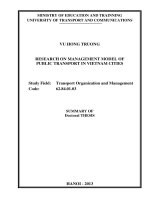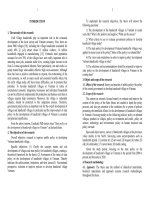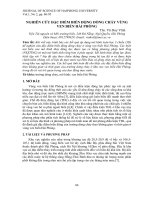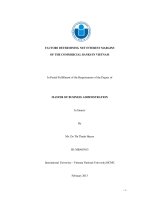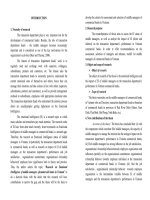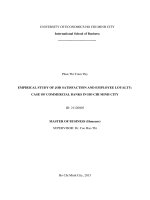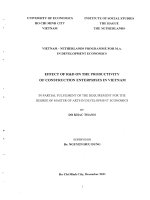Research on emotional intelligence of middle managers of commercial banks in vietnam
Bạn đang xem bản rút gọn của tài liệu. Xem và tải ngay bản đầy đủ của tài liệu tại đây (258.47 KB, 12 trang )
INTRODUCTION
develop the criteria for assessment and selection of middle managers of
commercial banks in Vietnam.
1. Necessity of research
2. Research purpose
The transaction department plays a very important role for the
development of commercial banks. Besides, the role of transaction
department heads – the middle managers becomes increasingly
important and is considered as one of the key motivations for the
organization’s activities (Mair and Thurner, 2008).
The researchpurpose of thesis aims to assess the IE status of
middle managers, as well as analyze the impact of EI (direct and
indirect) on the transaction department’s performance in Vietnam
commercial banks. In order to offer recommendations on the
assessment, selection of managers and enhance, trainEI for middle
managers of commercial banks in Vietnam.
The feature of transaction department heads’ work is to
regularly meet and exchange work with superiors, colleagues,
subordinates, partners and customers, etc. The feature asks the
transaction department heads to accurately perceive, understand the
current emotional state of themselves and others; hence they can
manage their emotions and take actions in line with others (superiors,
subordinates, partners and customers); as well as provide management
methods to subordinates, employees with appropriate emotional state.
The transaction department heads who understand the emotion process
above are usuallypeoples getting higherscore on the Emotional
Intelligence.
The emotional intelligence (EI) is a research topic to which
many scholars and researchers pay much attention. The research works
of EI have been done much recently; however,research on Emotional
Intelligence of middle managers in commercial banks is a research gap.
Therefore, the research on Emotional Intelligence status of middle
managers in Vietnam, in particularly the transaction department heads
in commercial banks; as well as research on impact of EI of middle
managers on the transaction department’s performance and job
satisfaction , organizational commitment, organizational citizenship
behaviorof employee have significance both in theory and practice.
Thus, the author selects the topic: “Research on Emotional
Intelligence of middle managers ofcommercial banks in Vietnam” to
do a doctoral thesis with the desire that this research will have
contributions to narrow the gap, and the thesis will be the basis to
3. Object and scope of research
Object of research
The object of research of the thesis is the emotional intelligence and
the impact of EI of middle managers on the transaction department’s
performance in Vietnam commercial banks.
Scope of research
The thesis researches on the middle managers of commercial banks
in Vietnam who are Directors, transaction department heads at branches
of commercial banks in provinces of Red River Delta (Hanoi, Nam
Dinh, Thai Binh, Hai Phong, Ninh Binh, etc.)
4. New contributions of the thesis
- In terms of the theory: The thesis has concluded that: (i) with
the components which constitute EIof middle managers, the capacity of
middle managers to manage the emotion has the strongest impact on the
transaction department’s performance in Vietnam commercial banks;
(ii) EIof middle managers has strong influence on the job satisfaction ,
organizational citizenship behaviortowards employee organization and
influences partially on the organizational commitment, organizational
citizenship behavior towards employee individual at the transaction
department of commercial banks in Vietnam; (iii) find the job
satisfaction , organizational citizenship behavior towards employee
organization is the intermediate variable between EI of middle
managers and the transaction department’s performance in Vietnam
commercial banks. This is the main finding and the new points of the
thesis.
- In terms ofpractice: the thesis not only contributes to the
theory, its findings, but also contributes to the practice both
organization and individual, which is proved that EI improvement will
help organization get the better performance and help employees
enhance the productivity, leadership effectiveness.
5. Outline of thesis
To state the entire content of the research, in addition the introduction
and conclusion, the outline of thesis consists of 5 chapters, as follows:
CHAPTER 1: THEORY BASIS OF EMOTIONAL
INTELLIGENCE OF MIDDLE MANAGERS OF COMMERCIAL
BANKS IN VIETNAM
1.1 Definition,
model
and
measurement
tool
of
emotional
intelligence
The emotional intelligence has been interested in so much recently,
EI is expected to influence the organization and human being
development; EI provides new approach to understand and evaluate
behavior, management style, ability, skill, etc. of an individual.
In terms of the net approach of capacity, the emotional intelligence
Chapter 1: Theory basis of emotional intelligence of middle managers
of commercial banks in Vietnam
is the capacity of individuals to accurately perceive, understand and
Chapter 2: Overview of research and research model
manage their own emotion; to accurately perceive (understand) others’
Chapter 3: Research method
emotion; to use emotional information to guide their own thinking and
Chapter 4: Findings
behavior.
Chapter 5: Discussion of findings and recommendations
In terms of EI model, it is divided into two models: ability model
and mixed model. The ability model pays much attention to how the
emotion influences on thinking, decision, plan and behavior of
someone. While the mixed model is generated on the base that EI not
only consists of the emotional capacities, but also so many other
attributes such as personality, personal motivation and social skills, etc.
The question “Is the emotional intelligence measured?”. According
to Encyclopedia of Application Psychology (2004), four the
measurement tools that are used most frequently in researches on EI are
MSCEIT, EQ-I, ECI, SSRI and these tools are studied carefully and
confirmed in terms of the statistics. SSRI required individuals to answer
some questions to evaluate themselves according to recognizing,
understanding about themselves. Thus, the tool can save survey time
and findings are more reliable. SSRI is used widely in researches and
researches with different scales show reliable and effective evidences
for researches on EI (Elizabeth J. Austin et al, 2004). According to
Based on EI model of Mayer and Salovey (1997), the emotional
Schutte et all, 2009, the researches on EI used the SSRI in analyzing
intelligence structure of middle managers of commercial banks in
factors that give appropriate EI constituent variables in terms of each
Vietnam includes:
variable’s name and not losing the SSRI’s effectiveness like the
Table 1.5: Emotional intelligence of middle managers of
research of Ciarrocchi et al (2001), Austin et al (2004).
commercial banks in Vietnam
1.2 Emotional intelligence of middle managers of commercial
banks in Vietnam
1.2.1 Introduction to middle managers of commercial banks in
Vietnam
According to Uyterhoeven (1972), the middle managers are the
managers at the intermediate management in the hierarchy of
companies and bears all responsibilities for the business results of
sales department. The middle managers may be construed as the
managers under senior managers / Board of Management and the
superior of group of supervisors (Heckscher, 1995)
Vietnam commercial banks features it organization structure
including many levels. For the scope of branch, the middle managers
of commercial banks in Vietnam includes head and deputy head of
departments of branches; director, head and deputy head of transaction
departments under the branches.
1.2.2 Emotional intelligence of middle managers of commercial
banks in Vietnam
According to EI definition of Mayer and Salovey, the emotional
intelligence of middle managers of commercial banks in Vietnamis the
capacity of individuals to accurately perceive, understand and manage
their own emotion; to accurately perceive (understand) others’
emotion; to use emotional information to guide their own thinking and
behavior.
EI of middle
managers in
Interpretation
Vietnam
Accurately
The capacity of individuals to accurately perceive
perceiving
their own emotion and others’ emotion
emotion
Using emotion
The capacity of individuals to use the emotion to
to facilitate
guide thinking, judgment and behavior
thought
Understanding
emotion
The capacity of individuals to understand the
emotional states, as well as reasons and
development of emotion
Managing
emotion
The capacity of individuals to manage their own
emotion, manage the emotion to aim to any social
target, manage others’ emotion
Source: Based on EI model of Mayer and Salovey (1997)
CHAPTER 2:
OVERVIEW OF RESEARCH AND RESEARCH MODEL
2.1 Overview of research on emotional intelligence of foreign
countries
2.1.1. Researches on the relation between EI and factors attributed to
managers
2.1.1.1. Relationbetween EI and gender
“Is there difference between male and female in terms of total
score and score for each EI constituent factor?”. This question has not
reached the agreement: some researchers said that there is difference in
terms of EI score between male and female (Mandell and Pherwani,
2003), Cavallo and Brenza (2002); while some supposed that there is no
difference in terms of EI score between male and female (Nikolaou and
Tsaousis,2002), Brooks (2002), (Goleman, 2003).
2.1.1.2. Relationbetween EI and age
Daniel Goleman (1995; 2004) declared that each person's EI
tends to increase over time, and he built the data, training programs to
improve the emotional intelligence. John Mayer et all (1999, 2003) also
said that EI score increases with age. However, these results are
contrary to the findings of Slaski and Cartwright (2003), scholars have
shown that there is no relation between age and EI - or the relation
between EI and age does not exist. Specifically, two authors research in
institutions whose employers’ ageis at the distance of four generations
and the research results indicate there is no basis to assert that EI
increases according to the different ages.
2.1.3. Relation between EI and educational qualification
No many researches have mentioned the relation between EI
and educational qualification.Because many scholars have considered
EI as a separate structure in comparison with the intelligence quotient
(IQ). In the researches on EI of leaders, Brooks (2002) found that the
educational qualification has no much impact on EI, but found that it is
different between EI of educated people in the science and the art.
However, Nikolaou and Tsaousis (2003) had a different opinion and the
findings have demonstrated that EI variable is significantly correlated
with the education duration (number of years).
2.1.1.4. Relation between EI and managers’ work performance
There are many experimental studies that have explored the
effect of EI and work performance, and the findings showthe positive
correlation between EI and job performance (Goleman, 1998; Bachman
et al, 2000;. Fox and Spector, 2000; Jordan et al, 2002; .. Wong and
Law, 2002; Slaski and Cartwright, 2002)
2.1.1.5 Relation between EI and managers
According to Fredrickson (2003), managers with high EI can
improve the performance of their subordinates by managing emotion
well that nurtures creativity, resilience and confidence of subordinates,
generating better cooperation results among employees (Barsade, 2002),
while helping employees organize their work, build a better
organization and contribute to improvework performance (Wong and
Law, 2002 ).
2.1.1.6. Relation between EI and leaders
When a leader with high EI, he/she is often willing to
contribute more to his/her organization (Abraham, 2000) and usually
expresses better at work (Goleman, 2000), uses relationship between
individuals well, builds trust and teamwork of employees better; and
making decisions and activities of the organization will be improved
when the leaderknows how to use their positive emotion and
employees’ positive emotion(George, 2000; Wong and Law, 2002). On
the other hand, if a leadercan’t manage his emotion, whichcauses
inefficiency in the quality of work, thinking and decision-making
process, interaction with others and dissatisfaction at work of
employees (Palmer, Jansen & Coetzee, 2006).
2.1.2. Researches on relation between EI and variables at
organization level
Venkatraman and Ramanujam (1986) suggested that
enterprise’s business result can be evaluated under the perspective of
financial performance; non-financial performance (performance
indicator); or a combination of the financial and non-financial
performance.\
In an experimental study, Rahim & Malik (2010) have
concluded that there is a direct relationbetween EI and the enterprise’s
business result. EI plays a coordinating role in the relationbetween
service supplier and customer satisfaction, is a fundamental motivation
of the enterprise’s business result (Rehman et al, 2012; Pahuja and Sahi,
2012). Thus, recent studies have suggested that there is a
relationbetween EI and the enterprise’s business result, but no study has
ever shown any factor in EI constituent factors of managers
thataffectsthe enterprise’s business result.
2.1.3 Researches on relation between EI and variables at employee
level
2.1.3.1 Relation between EI and job satisfaction
In the scope of the organization, the job satisfaction is positive
response emotion of employees to work when the value of work is
brought as expected (Olsen, 1993). Managers with high EI will
recognize and respond employees’ expectationat work. Luddy (2005)
suggested that superiors’ supervision is one of factors that
affectsemployees’ job satisfaction , along with other factors. Thus,
maybe EI of managers affectsemployees’ job satisfaction - this is
research gap on relation between EI and job satisfaction .
2.1.3.2 Relation between EI and organizational commitment
Organizational commitment (OC) can be understood as level of
consent and the most enthusiastic participationof an employee.
According to Meyer and Allen (1997), we can understand the
organizational commitment in three aspects: (i) emotional commitment;
(ii) continuance commitment; (iii) normative commitment.
Carmeli (2003) suggested that EI and the organizational
commitment have a positive relationship. However, Wong and Law
(2002) said that although EI has certain relation like job satisfaction and
organizational commitment, but EI has little impact on the level of
organizational commitment. Guleryuz et al (2008) also said that EI is
not directly related to the organizational commitment; and job
satisfaction as intermediary variable between EI and the organizational
commitment.
2.1.3.3 Relation between EI and organizational citizenship behavior
Organizational citizenship behavior (OCB) is considered as a
new approach in human resource management in many organizations
(Ertürk, 2007). Organizational citizenship behaviorincludes a set of
individual’s behaviors within the organization, which these behaviors
are actions that individuals perform beyond tasks and requirements of
work and actions that individuals do not expect recognition and reward
(Organ, 1988).
According to Podsakoff et al (2000), OCB includes - I is an
individual’s behavior that the individual voluntarily help others for
work matters; OCB - O is behaviors towardsthe common benefits of
organization.
Moghaddami et al (2011), Yaghoubi et al (2011) suggested that
there is a significant relationbetween EI of managers and OCB of
employees. However, findings have not indicated the extent of impact
of EI of managers on OCB-I, OCB-O of employees.This is also
researchgap on the relation between EI of managers and OCB of
employees.
2.2 Researches on emotional intelligence in Vietnam
In Vietnam, researches on “Emotional intelligence” are
conducted by some scholars, researcher and they have obtained findings
both the theory and practice:
- Firstly, in terms of theory, the researches tend to unify terms,
definitions, models and measurement tools
- Secondly, researches on “Emotional intelligence” are carried
out mainly in the education and somefindings are similar to that of
foreign scholars.
2.3 Research gap and research orientation of topic
2.3.1 Research gap
From the research overview result, the authorfinds that research
orientation on emotional intelligenceof middle managers of commercial
banks in Vietnamis new research orientation and has the research gap
on EI.
2.3.2 Research orientation and model of topic
The topic towards the research on EI of middle managers of
commercial banks in Vietnam aims to answer the question: is there any
close relation between EI of middle managers and the job satisfaction ,
organizational commitment and organizational citizenship behavior of
employees?; and which factor of the EI constituent factors of
managersmainly affects on the transaction department’s performance?
2.4 Research model and hypothesis
Research model
Based on the theory and overview of researches on EI, the research
model of thesis is proposed, as follows:
Transaction
department’s
performance
EI of middle managers
of commercial banks in
Vietnam
• Accurately perceive
emotion
• Use emotion
• Understand emotion
• Manage emotion
Research hypothesis
Hypothesis
H1
H2
H3
H4
H5
H6
H7
Employees’
job
satisfaction
Employees’
organizational
commitment
H8
H9
H10
Employees’
organizational
citizenship
behavior
H11
H12
Table 2.2: Research hypothesis
Content
EI of middle managers has impact on employees’ job
satisfaction in the transaction department of Vietnam
commercial banks
EI of middle managers has impact on employees’
organizational commitment in the transaction department of
Vietnam commercial banks
EI of middle managers has impact on employees’ OCB
towards organization in the transaction department of
Vietnam commercial banks
EI of middle managers has impact on employees’ OCB
towards individual in the transaction department of Vietnam
commercial banks
The capacity of middle managers to accurately perceive the
emotion has impact on the transaction department’s
performance of Vietnam commercial banks
The capacity of middle managers to use the emotion has
impact on the transaction department’s performance of
Vietnam commercial banks
The capacity of middle managers to understand the emotion
has impact on the transaction department’s performance of
Vietnam commercial banks
The capacity of middle managers to manage the emotion
has impact on the transaction department’s performance of
Vietnam commercial banks
Employees’ job satisfaction has intermediate impact on the
relation between EI of middle managers and the transaction
department’s performance of Vietnam commercial banks
Employees’ organizational commitment has intermediate
impact on the relation between EI of middle managers and
the transaction department’s performance of Vietnam
commercial banks
Employees’ OCB towards organization has intermediate
impact on the relation between EI of middle managers and
the transaction department’s performance in Vietnam
commercial banks
Employees’ OCB towards individual has intermediate
impact on the relation between EI of middle managers and
the transaction department’s performance in Vietnam
commercial banks
CHAPTER 3: RESEARCH METHOD
3.1. Research design
From the research purpose and to interpret the survey results
more clearly, the research process includes two stages: preliminary
research and officialresearch. In particular, the preliminary research
aims to propose the research model and scale; for the official research,
the author releases a questionnaire and then collects them, enters data
and analyze factors and verify according to multivariate regression.
3.2. Scale
Scale which is used to measure the concepts in the research
model is the scale used inmuch scientific works and verified thoroughly
in terms of the statistics:
Table 3.1: Variable scale in the model
Variable
Accurately perceiving
emotion
Using emotion
Understanding emotion
Source
Ciarrochi et all developed the scale of
components (based on the scale of SSRI
of Schutte et all, 1998)
Transaction department’s
performance
Based on the scale developed by Phan
Thuc Anh et al (2006)
Job satisfaction
Judge et al (2005)
Organizational
commitment
Meyer et al (1993)
OCB towards individual
To ensurethe science and conformity of research model, the
concept and scale of the variable in the model, as well as the findings
interpretation, the author has used the research method at the table,
including to interview experts and middle managers to understand more
about the impact of EI of middle managers on the transaction
department’s performance.
3.4. Pre-testing
The purpose of pre-testing is to detect weaknesses in the design
and question structure (Cooper& Schindler, 1998; Fink, 2003);in
addition, to minimize the problems during answering questionnaire and
entering data (Saunders et al, 2007). The author has surveyed 10
transaction department heads and 15 employees at Vietinbank, Thanh
Xuan branch, Hanoi and Agribank, Nam Dinh branch. The result of pretesting is that basically, the questionnaire is accepted, just adjust some
of the terms and design.
3.5. Quantitative research
Managing emotion
OCB towards organization
3.3 Qualitative research
Podsakoff et al (1990,1994)
Source: The author sumps and develops
Research sample
Research sample has been selected by convenience sampling
method. The author has conducted a survey at the transaction
departments ofcommercial banks (Vietinbank, Vietcombank, BIDV,
Agribank, Mbank) and some commercial banks whichare not owned by
the State (VP Bank, Lienvietpostbank, VIB) in Hanoi, Hai Phong, Nam
Dinh, etc.In each locality, the author has selected the transaction
departments which are located in cities, towns and districts in the
geographical aspect.
In terms of objectswho answer the questionnaire, the author
onlysurveyedEI of the transaction department heads and performance of
transaction departments of Vietnam commercial banks they charge. For
the questionnaire for employees, the author investigated subordinates of
those middle managers.
Data collection
The data collection has beenconducted by direct survey methodat
125 transaction departments (both heads and subordinates) and by
indirect survey methodat 135 transaction departments (heads).
Data analysis
After collecting the questionnaire answers, the author has
filteredthe information, filtered the questionnaire and encoded the
necessary information in the questionnaire, entered the data and
analyzed it through SPSS software: (i) Inspectvariable values by
exploratory factor analysis (EFA); (ii) Evaluate the reliability of the
scalethrough Cronbach alpha reliability coefficient; (ii) Testthe
multivariate regression.
CHAPTER 4: FINDINGS
4.1 Descriptive statistics
Through the convenience sampling method, the author
collected 217 answers from middle managers (account for 90.97%) and
342 answers from employees (account for 92.18%). The average age of
middle managers who take part in the research is 35 years old; the
educational qualification is mainly level 3 – university and level 4Master; the highest seniority is 18 years and the lowest is 5 years; the
average number of years of middle manager holding is 3.26 years.
4.2 Distribution inspection of scale
The findings show that the minimum value (Min) and the
maximum value (Max) of the scale is from 1 to 5, which implies that
there is no fluctuation limit for the scale that is used and the scale is
suitable, ensure the inspection requirement and nest analysis.
4.3 Variable value inspection
By exploratory factor analysis (EFA), KMO and Bartlett value as
inspecting the independent variable is 0.732 (>0.5) and sig=0.000 <
0.005. Besides, factor loadings values is more than 0.5. The results
leading to the conclusion is the scales with the high values as being
used to measure the corresponding variables.
4.4 Reliability inspection of scale
Variable
Cronbach’s Alpha
Capacity to accurately perceive the
emotion
.782
Capacity to use the emotion
.777
Capacity to understand the emotion
.648
Capacity to manage the emotion
.751
Transaction department’s performance
.732
Job satisfaction
.719
Organizational commitment
.821
OCB towards organization
.779
OCB towards individual
.652
4.5 Relation between factors attributed to managers and emotional
intelligence of middle managers
The inspection results has shown that: (i) not to assert that there is
difference between EI of male middle managers and EI of female
middle managers (P-value=0.379>0.05); (ii) there is difference of EI of
middle managers according to the educational qualification (Pvalue=0.000<0.05); (iii) there is positive relation between the seniority
in banking, the number of years of position holding and EI of middle
managers of commercial banks in Vietnam.
4.6 Correlation inspection of variables
The result of correlation analysis has shown that there is relation
between EI of middle managers and job satisfaction, organizational
commitment of employees, OCB-O of employees (P-value ≤0.05).
While there is no basis to assert relation between EI of middle managers
and OCB-I of employees by (P-value = 0.063>0.05)
4.7 Hypothesis inspection
4.7.1. Relation between EI of middle managers and variables at
employee level
The inspection result has shown that: EI of middle managers
has strong impact on the job satisfaction, OCB towards organization of
employees and has little impact on the organizational commitment,
OCB towards individual of employees at the transaction department of
Vietnam commercial banks. Thus, the hypothesis H1, H2, H3, H4are
supported.
4.7.2 Relation between EI of middle managers and the transaction
department’s performance in Vietnam commercial banks
The inspection result has shown that EI constituent factors of
middle managers have positive impact on the transaction department’s
performance. The capacity to manage the emotion has the strongest
impact on the transaction department’s performance (Beta=0.257), then
the capacity to use the emotion (beta=0.182), and the capacity to
accurately perceive the emotion has the lowest impact (Beta=0.017).
Thus,the hypothesis H5H6, H7, are supported.
4.7.3 Relation of EI of middle managers, variables at employee level
and the transaction department’s performance in Vietnam
commercial banks
The inspection result has shown that: (i) the capacity to manage
the emotion has the strongest impact on the transaction department’s
performance; (ii) the job satisfaction, OCB towards organization of
employees have intermediate impact on the relation between EI of
middle managers and the transaction department’s performance in
Vietnam commercial banks. (P-value<0.05 and R2 adjusted to increase
from 0.429 in the model 1 to 0.552 in the model 2). Thus, the
hypothesis H9, H11 are supported; (iii)there is no basis to assert that the
organizational commitment, OCB towards individual of employees
have intermediate impact on the relation between EI of middle
managers and the transaction department’s performance in Vietnam
commercial banks (P-value>0.05). Thus, the hypothesis H10, H12 are not
supported.
CHAPTER 5:
DISCUSSION OF FINDINGS AND RECOMMENDATIONS
5.1 Key findings
The findings of the thesis has suggested that: (i) there is
difference of EI of middle managers according to the higher educational
qualification, the seniority, the number of years of current position
holding; however, it has not asserted that there is difference between EI
of male middle managers and EI of female middle managers; (ii) EI of
middle managers has strong impact on the job satisfaction, OCB
towards organization of employees and has little impact on the
organizational commitment, OCB towards individual of employees at
the transaction department of Vietnam commercial banks; (iii) the job
satisfaction, OCB towards organization of employees have intermediate
impact on the relation between EI of middle managers and the
transaction department’s performance in Vietnam commercial banks.
Especially, the findings have shown that the capacity of middle
managers to manage the emotion has the strongest impact on the
transaction department’s performance in Vietnam commercial banks.
5.2 Findings discussion
The thesis has shown the findings which express the consensus /
difference and some new contribution in comparison with the previous
researches.
Firstly, the findings of the thesis shown that there is positive
relation between the seniority, the number of years of current position
holding and EI of middle managersof commercial banks in Vietnam –
this has the same opinion as that of Daniel Goleman (1995, 2004),
Mayer, Salovey et all (199, 2003), Nikolaou and Tsaousis (2002) and is
contrary tothe findings of Slaski and Cartwright (2003). Why so? The
author said this findings are interpreted by individuals who have more
years of accumulated experience(the seniority), they have more
opportunities to experience in work situations, helping them improve EI
of individuals and this explains the reason why the middle managers
have the seniority, they have higher EI.
Secondly, the findings of thesis shown that there is no
difference between EI of male middle managers and EI of female middle
managersof commercial banks in Vietnam – thisexpresses the consensus
with the researches of Nikolaou and Tsaousis (2002), Brooks (2002),
Daniel Goleman (2003) and contrary to the findings of Cavallo and
Brenza (2002). Because there is no difference, the middle manager
should accurately perceive, understand the emotion of partners and
know how to manage their own emotion to exact behaviors and
decisions at work. These capacities are necessary for both male middle
managers and female middle managers.
Thirdly, the findings of the thesis shown that: there is relation
between the educational qualification and EI of middle managers of
commercial banks in Vietnam – this expresses the findings of Nikolaou
and Tsaousis (2003) that EI variable has significant correlation with the
education duration (number of years).
Fourthly, the thesis has concluded that: EI of middle managers
strong impact on the job satisfaction of employees and has little impact
on the organizational commitment of employees. This findings
expressed the consensus with the findings of Wong and Law (2002).
These findings implies that high EI helps managers perform their
important roles well in human resource communication (roles of
representative, leaders and connecting people), etc. besides, high EI
assists managers to understand subordinates’ mood, why they feel like
that and how to manage that feeling. Then, managers assign their
employees suitable tasks, as well as know how to maintain employees’
enthusiasm, reliability and motivate them to reach organization’s targets
and increase employees’ job satisfaction.
Fifthly, the thesis has researched a new topic that is considered
as the research gap in terms of organizational behavior, it is
organizational citizenship behavior – OCB. The findings of the thesis
have shown that: EI of middle managers has influence on OCB towards
organization and OCB towards individual of employees of commercial
banks in Vietnam – thisexpressed the consensus with the findings of
Sitter (2004), Moghaddami et all (2011), Yaghoubi et all (2011). This
conclusion may be stemmed from the findings of Conger and Kanungo
(1998), which indicates that the importance of effective leadership
creating positive influence at workplace. With high EI, the managers
can accurately perceive, understand employees’ emotion and based on
subordinates’ emotion information, the managers know how to promote
employees’ optimism and enthusiasm. That optimism and enthusiasm of
employees will make employees work with positive attitude and that
positive attitude will lead positive behavior including OCB of
employees.
Sixthly, the thesis has concluded that there is relation between
EI constituent capacities of middle managers and the transaction
department’s performance in Vietnam commercial banks, in which the
capacity to manage the emotion has the strongest impact on the
transaction department’s performance in Vietnam commercial banks.
The conclusion expresses the consensus with opinion of middle
managers of commercial banks in Vietnam: “I think that, recognizing
the emotion of myself as well as the emotion of others is not difficult,
but managing the emotion to keep calm before situations is much more
difficult”; or other manager stated the role of capacity to manage the
emotion for leaders: “It is true that the emotion is very important for us,
but when we are leaders, we shouldn’t let our emotion influence
decision-making too much…”
Seventhly, the findings of the thesis concluded that: the job
satisfaction and OCB towards organization of employees are the
intermediate variable between EI of middle managers and the
transaction department’s performance in Vietnam commercial banks.
This result is construed that positive leaders (they know how to manage
negative emotion and use positive emotion) often create relation and
manage employees’ activities appropriately, know how to encourage
and inspire employees, foster the positive attitude at work, contribution
desire of subordinates and make them understand the importance of
teamwork to reach organization’s targets (Hogan et all, 1994).
5.3 Contribution to the theory
The findings have shown thatthe thesis has contributed to the
theory and academics, in particularly:
-
Continue to assert the role of emotion, emotional intelligence for
the leadership effectiveness of managers
-
Research on the emotional intelligence of middle managers
(transaction department head) in commercial banks, an object of
research has not ever been studied; the findings has also asserted
that the capacity of middle managers to manage the emotion has the
strongest impact on the transaction department’s performance in
Vietnam commercial banks. This is new point and contribution of
thesis to the theory;
-
The findings have shown that: EI of middle managers has strong
impact on the job satisfaction, OCB towards organization of
employees and has little impact on the organizational commitment,
OCB towards individual of employees. This is new point and
contributionof thesis to the theory;
-
The findings have shown that: the job satisfaction, organizational
citizenship behavior towards organization of employees are the
intermediate variable between EI of middle managers and the
transaction department’s performance in Vietnam commercial
banks.This is new point and contributionof thesis to the theory;
5.4 Contribution to the practice
(1) Contribution to organizations and enterprises:
- Leaders / entrepreneurs have bases and scientific basis for
improving the emotional intelligence of managers and employees,
which helps increase the productivity of individuals and the
performance of departments and organizations;
- Recommend to usenew criteria to assess the effectiveness of
management and administration of managers in enterprises /
organizations in Vietnam, including the criteria:the job satisfaction,
organizational commitment and organizational citizenship behavior of
employees / subordinates
(2) Contribution to leaders / managers and individuals:
- Leaders / managers realize that the emotional intelligence
improvement will help them be more successful in work and life
- Leaders / managers need to recognize that the goal of
administration is to increase the job satisfaction, organizational
commitment and organizational citizenship behavior of employees:
5.5 Limitations of research and subsequent researchdirections
5.5.1 Limitations of research
Like other researches, the author’s research still has some
limitations: research sampling method, convenience sampling method;
the scope and object of research, limiting the scope of research in terms
of space as commercial banks in Red River Delta and only choosing
middle managers in Vietnam commercial, including Director /
Transaction Department Head of branches; not developing new scale.
5.5.2 Subsequent research directions
With the limitations of research, the authorthinks that research
on emotional intelligence in general and emotional intelligence of
middle managers in the futuremay focus on following research
directions: (i) Research on emotional intelligence according to
occupation; (ii) Research on comparing emotional intelligence of
middle managers in commercial banks (branch manager, head of
department, Director / transaction department head; (iii) Research on
relationbetween emotional intelligence of middle managers of
commercial banks in Vietnamand other factors attributed to individuals
or factors attributed to others.
CONCLUSION
The emotional intelligence (EI) has been interested in so much
recently, EI provides a new approach to understandand evaluate
behavior, management style, capacity, skill, etc. of an individual. The
thesis has researched on emotional intelligence of middle managers of
commercial banks in Vietnam, this is new research which has never
been done in the previous researches in Vietnam. The findings of the
thesis has continued to assert the role of emotional intelligence for the
leadershipeffectiveness of managers; besides, the findings has indicated
that EI of middle managers has strong impact on the job satisfaction,
OCB towards organization of employees and has little impact on the
organizational commitment, OCB towards individual of employees at
the transaction department of Vietnam commercial banks; the job
satisfaction, organizational citizenship behavior towards organization
of employees have intermediate impact on the relation between EI of
middle managers and the transaction department’s performance in
Vietnam commercial banks. In particular,the capacity of middle
managers to manage the emotion has the strongest impact on the
transaction department’s performance in Vietnam commercial banks.
This is the main result, new point and contributionof the research to
boththeory and practice.

